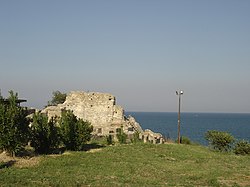Archea Pydna
|
Archea Pydna Αρχαία Πύδνα |
||
|---|---|---|
|
|
||
| Basic data | ||
| Country |
|
|
| region | Central Macedonia | |
| Regional district | Pieria | |
| local community | Pydna-Kolindros | |
| Parish | Methoni | |
| Geographic coordinates | 40 ° 24 ' N , 22 ° 37' E | |
| Residents | 25 (2011) | |
| LAU-1 code no. | 1103030102 | |
| Byzantine ruins of Pydna | ||
Archea Pydna ( Greek Αρχαία Πύδνα [ arˈçɛa ˈpiðna ] ( f. Sg. ) 'Ancient Pydna') is a small coastal town in the municipality of Pydna-Kolindros in the Greek region of Central Macedonia . The place was recognized as a settlement in 1981 and is located in the immediate vicinity of the ancient Macedonian port city of Pydna .
location
Archea Pydna is less than 2 km south of Makrygialos on the Thermaic Gulf . Some of the houses are built right next to the ancient and medieval archaeological site of Pydna .
history
The earliest settlement in the region dates back to the pre-Dimini period . About 1.5 km northwest of the national road 1 southwest of Makrygialos is a late Neolithic settlement with two settlement phases. During the Bronze Age the settlement was moved about 1.5 km southeast to the coast of the Thermaic Gulf. Due to sea erosion, only a small part has been preserved. It reached its maximum extent in the early Geometric Period , while settlement activities declined significantly in the Archaic period .
In the 5th century BC Under Alexander I , Pydna developed into one of the largest cities and the main port of the Macedonian kingdom. After the destruction by Archelaus I , the settlement was moved to the hinterland, presumably to today's Kitros . After being captured by the Athenian strategist Timotheus and the brief Athenian influence, Pydna came under Macedonian power again during the reign of Philip II . In the Hellenistic period, Pydna was the most important urban center in the north of Pieria. After the Battle of Pydna in 168 BC. The city lost its importance considerably. During the Byzantine period , Pydna became a bishopric under the name Kitros. Eventually the coastal settlement was abandoned in the 15th century after the Ottoman conquest.
The modern place Archea Pydna was recognized in 1981 as a settlement of the then rural community Makrygialos ( Κοινότητα Μακρυγιάλου Kinótita Makrygiálou ). As a result of the merger with three other rural communities as part of the 1997 regional reform , Archea Pydna became part of the Methoni municipality , which has had the status of a municipality in the municipality of Pydna-Kolindros since the administrative reform in 2010 .
- Population development of Archea Pydna
| 1981 | 1991 | 2001 | 2011 |
|---|---|---|---|
| 3 | 19th | 21st | 25th |
Web links
- Jona Lendering: Pydna . In: Livius.org (English)
Individual evidence
- ↑ Results of the 2011 census at the National Statistical Service of Greece (ΕΛ.ΣΤΑΤ) ( Memento from January 7, 2013 in the Internet Archive ) (Excel document, 2.6 MB)
- ↑ Manthos Besios: Pydna . In: Archaeologia . No. 63, 1997, pp. 56-63 .; Miltiades B. Hatzopoulos, Paschalis Paschidis: Makedonia . In: Mogens Herman Hansen , Thomas Heine Nielsen (Ed.): An inventory of archaic and classical poleis. Oxford University Press, Oxford 2004. ISBN 0-19-814099-1 , p. 806.
- ↑ Κεντρική Ένωση Δήμων και Κοινοτήτων Ελλάδας (ΚΕΔΚΕ) Ελληνική Εταιρία Τοπικής Ανάπτυξης και Αυτοδιοίκησης (Ε.Ε.Τ.Α.Α.) (ed.): Λεξικό Διοικητικών Μεταβολών των Δήμων και Κοινοτήτων (1912-2001). Volume 2 (Τόμος Β, λ – ω), Athens 2002, ISBN 960-7509-47-1 , p. 67.
- ↑ Population of Archea Pydna 1981–2011 Greek Statistical Office ELSTAT, Digital Library ; Census 2011 (Greek)

